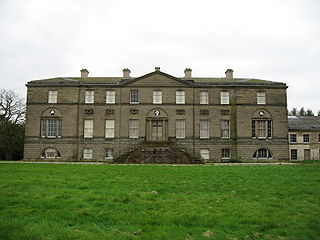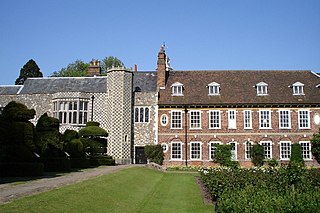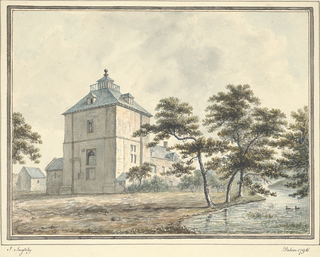Baron Wrottesley, of Wrottesley in the County of Stafford, is a title in the Peerage of the United Kingdom. It was created on 11 July 1838 for Sir John Wrottesley, 9th Baronet. He was a Major-General in the Army and also represented Lichfield, Staffordshire and Staffordshire South in House of Commons. The Wrottesley family's original patronymic was 'de Verdun', which meant that the creation of the title Baron Wrottesley represented the third barony created by a branch of the de Verdun family in England. The other two were established by Theobald de Verdun, 1st Baron Verdun of Alton Castle and Sir John de Verdon, 1st Baron Verdon, lord of Brixworth in Northamptonshire and Bressingham in Norfolk.

The Swinburne Baronetcy, of Capheaton in the county of Northumberland, was a title in the Baronetage of England. It was created on 26 September 1660 for John Swinburne in honour of the loyalty to Charles I of Swinburne's father and grandfather prior to and during the English Civil War. He demolished Capheaton Castle in 1668 and built a new house on the site. The sixth baronet was member of parliament for Launceston in 1788-9 and high sheriff of Northumberland in 1799. His grandson, the seventh baronet, was high sheriff in 1866 and member of parliament for Lichfield 1885–1892. His son, the eighth baronet was high sheriff in 1920. The title became extinct on the death of the tenth baronet in 1967.

Sir John Swinburne, 7th Baronet was a British Baronet and Liberal politician.

The Broughton, later Broughton-Delves, later Broughton Baronetcy, of Broughton in the County of Stafford, is a title in the Baronetage of England. It was created on 10 March 1661 for Sir Brian Broughton, of Broughton Hall, near Eccleshall, Staffordshire, High Sheriff of Staffordshire from 1660 to 1661 and the member of an ancient Staffordshire family.
There has been one creation of baronets with the surname Delves.

Three baronetcies have been created in the Baronetage of England for members of the Littleton or Lyttelton family. All three lines are descended from Thomas de Littleton, a noted 15th-century jurist. Despite differences in the spelling of the title, the names of all three lines were spelt in many varied ways in the early modern period, without distinction between the different branches of the family. This can be confusing, as the range of forenames in use was very limited.
The Mander baronetcy, of The Mount, Tettenhall Wood, in the County of Staffordshire, was created in the Baronetage of the United Kingdom on 8 July 1911 in the Coronation honours of King George V, for Sir Charles Tertius Mander, English varnish and colour manufacturer and public servant.

There have been two Baronetcies created for persons with the surname Austen, one in the Baronetage of England and one in the Baronetage of Great Britain. Both creations are extinct.

There have been twenty one baronetcies created for persons with the surname Williams, eight in the Baronetage of England, three in the Baronetage of Great Britain and ten in the Baronetage of the United Kingdom. Only six of the creations are extant as of 2017.
There have been three baronetcies created for members of the Mosley family, one in the Baronetage of England and two in the Baronetage of Great Britain. Only one creation is extant. Since 1980, the title has been held jointly with Baron Ravensdale in the Peerage of the United Kingdom.

Sir Oswald Mosley, 2nd Baronet, was an English aristocrat, politician, historian and naturalist. He served as a Member of Parliament (MP) for several constituencies, authored several works in the aforementioned subjects and was High Sheriff of Staffordshire in 1814. A prominent Staffordshire landowner, he succeeded as the 2nd Baronet Mosley, of Ancoats, in 1798.
There have been six baronetcies created for persons with the surname Thomas, three in the Baronetage of England, one in the Baronetage of Great Britain and two in the Baronetage of the United Kingdom. Two of the creations are extant as of 2016.
The Villiers Baronetcy, of Brooksby, in the County of Leicester was created in the baronetage of England on 19 July 1619 for William Villiers of Brokesby, Leicestershire. A member of the prominent Villiers family, he was the son of George Villiers, brother of Sir Edward Villiers,, and the half-brother of George Villiers, 1st Duke of Buckingham, Christopher Villiers, 1st Earl of Anglesey, and John Villiers, 1st Viscount Purbeck. He was high sheriff of Leicestershire in 1609. The third baronet sat as member of parliament for Leicester from 1698 to 1701. On his death in 1712 the title became extinct.
This is a list of the sheriffs and high sheriffs of Staffordshire.

The Baronetcy of Gresley of Drakelow was created in the Baronetage of England on 29 June 1611 for George Gresley of Drakelow Hall, Derbyshire who was later High Sheriff of Derbyshire and Member of Parliament for Newcastle-under-Lyme.

There have been two baronetcies created for persons with the surname Leighton, one in the Baronetage of England and one in the Baronetage of the United Kingdom. One creation is extant as of 2010.

The Boynton baronetcy, of Barmston in the County of York, was a title in the Baronetage of England. It was created on 15 May 1618 for Matthew Boynton, son of Sir Francis Boynton of Barmston Hall, in the East Riding of Yorkshire. The Boyntons came to Barmston following the marriage of heiress Margaret de la See to Sir Henry Barmston in the 15th century. The first Baronet married Francis Griffith, heiress of an estate at Burton Agnes including Burton Agnes Hall and Burton Agnes Manor House which the second Baronet inherited in 1647. The fifth and sixth Baronets both served as High Sheriff of Yorkshire, in 1750 and 1771 respectively. The eleventh Baronet died without male issue and the Baronetcy passed to his cousin. His estates however passed to his daughter Cicely whose husband Thomas Lamplugh Wickham changed his name on marriage to Wickham-Boynton, and later (1989) to Cunliffe-Lister relations descended from Mary Constance Boynton, wife of the 1st Earl of Swinton. The title became extinct on the death of the thirteenth Baronet in 1966.
The Sheriff of County Dublin was the Sovereign's judicial representative in County Dublin. Initially, an office for a lifetime, assigned by the Sovereign, the Sheriff became an annual appointment following the Provisions of Oxford in 1258. The first recorded Sheriff was Ralph Eure, appointed in that year. The next recorded Sheriff was Sir David de Offington, who was Sheriff in 1282. Besides his judicial importance, the sheriff had ceremonial and administrative functions and executed High Court Writs.
The Button Baronetcy, of Alton in the County of Wiltshire, was a title in the Baronetage of England. It was created on 18 March 1622 for Sir William Button, Member of Parliament for Morpeth and Wiltshire. The third Baronet was High Sheriff of Wiltshire from 1670 to 1671. The title became extinct on the death of the fourth Baronet in 1712.

Sir Humphrey Style, 1st Baronet of Beckenham, Kent was a courtier to kings James I and Charles I of England.










